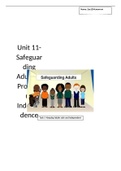Name: Zae12Mcmorrow
Unit 11-
Safeguar
ding
Adults &
Promoti
ng
Indepen
dence Task 1- Keeping Adults safe and Independent
, Introduction
In this unit, the aim is to be aware of the different types of abuse and to understand why this may
happen. During this unit, learners will be able to develop knowledge of safeguarding adults, and an
understanding of how independence and the wellbeing of adults are promoted through a person-
centred, multi-agency approach. It is important for learners, to develop knowledge and
understanding of safeguarding adults. Multi-agency partnerships work at local level to develop
policies and procedures which safeguard adults by promoting good practice. Learners will explore a
range of strategies and procedures organisations use to reduce the risks to individuals and know the
key legislation and regulations which govern safeguarding work in the health and social care sectors.
P1- Describe forms of abuse which may be experienced by adults/ P2- Describe indicators that
abuse may be happening to adults.
What is abuse?
Abuse can take many forms, ranging from causing harm, distress and causing someone mental or
physical pain. It can transpire in someone’s home, a hospital, a care home or a public place.
Generally, the people who commit abuse can take advantage of a friendship, family or a consensual
relationship. Abusers may try to prevent access to the person they abuse.
What are the different types/forms of abuse?
The different forms of abuse are physical abuse, neglect, psychological abuse and sexual abuse.
Physical Abuse
Physical abuse is when someone hurts or harms a child,
young person, elderly or a vulnerable individual on purpose.
The types of physical abuse can range from: physical
punishments, assault e.g. hitting, slapping, biting, pushing,
Scalding and burning, forcible feeding or withholding food,
misuse of medication (e.g. over-sedation), involuntary
isolation or confinement and many more. For example, in
the case study, Mrs B’s son Michael was involuntary isolating
her from going outside the house and took her mobile
phone, which is a form of physical abuse.
The possible indicators of physical abuse are frequent injuries, failure to seek medical treatment or
frequent changes of GP, injuries are inconsistent with the person’s lifestyle, subdued or changed
behaviour in the presence of a particular person, signs of malnutrition, bruising, cuts, welts, burns
and/or marks on the body or loss of hair in clumps, no explanation for injuries or inconsistency with
the account of what happened. For example, in a care home a resident could be getting physically
abused and could be showing signs of bruising on their body when a staff member is changing them.
Neglect
Neglect is a form of mistreatment by individuals which can result from inadequate attention,
especially through carelessness or disregard for the needs of others. In a care home it can be
intentional or an unintentional act of failing to provide the proper care to care home residents.
Neglect is different from abuse, whereas abuse is a deliberate act performed against someone with
the malicious intent to cause harm in some way.





